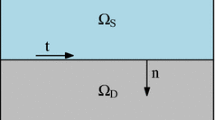Abstract
We consider the discretization of the stationary Navier–Stokes/Darcy system in a two-dimensional domain by the non-conforming finite volume element method. We use the standard formulation of the Navier–Stokes/Darcy system in the primitive variables and take as approximation space the non-conforming \(P_{1}\) elements for velocity and piezometric head and piecewise constant elements for the hydrostatic pressure. We prove that the unique solution of the non-conforming finite volume element method converges to the true solution with optimal order for velocity and piezometric head in discrete \(H^{1}\) norm and for pressure in discrete \(L^{2}\) norm, respectively. Finally, some numerical experiments are presented to validate our theoretical results.




Similar content being viewed by others
References
Arnolo DN, Brezzi F (1985) Mixed and nonconforming finite element methods:implementation, postprocessing and error estimates. Modélisation mathématique et analyse numérique 19(1):7–32
Bank RE, Rose DJ (1987) Some error estimates for the box methods. SIAM J Numer Anal 24(4):777–787
Barth T, Bochev P, Gunzburger M, Shadid J (2004) A taxonomy of consistently stabilized finite element methods for the Stokes problem. SIAM J Sci Comput 25:1585–1607
Beavers G, Joseph D (1967) Boundary conditions at a naturally permeable wall. J Fluid Mech 30:197–207
Blasco J, Codina R (2000) Stabilized finite element method for the transient Navier–Stokes equations based on a pressure gradient projection. Comput Method Appl Mech Eng 182:277–300
Bochev P, Dohrmann C, Gunzburger M (2006) Stabilization of low-order mixed finite elements for the Stokes equations. SIAM J Numer Anal 44:82–101
Cai M, Mu M, Xu J (2009) Numerical solution to a mixed Navier–Stokes/Darcy model by the two-grid approach. SIAM J Numer Anal 47:3325–3338
Cao Y, Chu Y, He X, Wei M (2013) Decoupling the stationary Navier–Stokes-Darcy system with the Beavers–Joseph-*Saffman interface condition. Abstr Appl Anal 136483:10
Cesmalioglu A, Riviere B (2008) Analysis of time-dependent Navier–Stokes flow coupled with Darcy flow. J Numer Math 16:249–280
Cesmalioglu A, Riviere B (2009) Primal discontinous Gelerkin method for time-dependent coupled surface and subsurface flow. J Sci Comput 40:115–140
Chatzipantelidis P (1999) A finite volume method based on the Crouzeix-element for elliptic PDE’s in two dimensions. Numer Math 82:409–432
Chou S, Kwak D (1998) A covolume method based on rotated bilinears for the generalized Stokes problem. SIAM J Numer Anal 35:494–507
Djadel K, Nicaise S (2008) A non-conforming finite volume element method of weighted upstream type for the two-dimensional stationary Navier-Stokes system. Appl Numer Math 58:615–634
Girault V, Riviere B (2009) DG approximation of coupled Navier–Stokes and Darcy equations by Beaver–Joseph–Saffman interface comdition. SIAM J Numer Anal 47:2052–2089
He Y, Wang A, Mei L (2005) Stabilized finite element method for the stationary Navier–Stokes equations. J Eng Math 51:367–380
Li J, Chen ZX (2008) A new stabilized finite volume method for the stationary Stokes equations. Adv Comput Math 30:141–152
Li R, Chen Z, Wu W (2000) Generalized difference methods for differential equations-numerical analysis of finite volume methods. In: Monographs and textbooks in pure and applied mathematics, vol 226. Marcel. Dekker. Inc., New York
Li J, He Y (2008) A new stabilized finite element method based on two local Gauss integrations for the Stokes equations. J Comp Appl Math 214:58–65
Mu L, Ye X (2011) A finite volume method for solving Navier–Stokes problems. Nonlinear Anal 74:6686–6695
Shen J (1995) On error estimates of the penalty method for unsteady Navier–Stokes equations. SIAM J Numer Anal 32:386–403
Ye X (2004) A discontinuous finite volume method for the elliptic problem. SIAM J Numer Anal 42:1062–1072
Ye X (2006) A discontinuous finite volume method for the Stokes problem. SIAM J Numer Anal 44:183–198
Zhang T, Tang L (2014) A stabilized finite volume method for Stokes equations using the lowest order P1–P0 element pair. Adv Comput Math:1–18
Zuo L, Hou Y (2015) A two-grid decoupling method for the mixed Stokes–Darcy model. J Comp Appl Math 275:139–147
Acknowledgments
The work was supported by the National Natural Science Fund of China (11371289).
Author information
Authors and Affiliations
Corresponding author
Ethics declarations
Conflict of interest
The authors declare that they have no competing interests.
Additional information
Communicated by Domingo Alberto Tarzia.
Rights and permissions
About this article
Cite this article
Wu, Y., Mei, L. A non-conforming finite volume element method for the two-dimensional Navier–Stokes/Darcy system . Comp. Appl. Math. 37, 457–474 (2018). https://doi.org/10.1007/s40314-016-0355-3
Received:
Revised:
Accepted:
Published:
Issue Date:
DOI: https://doi.org/10.1007/s40314-016-0355-3



